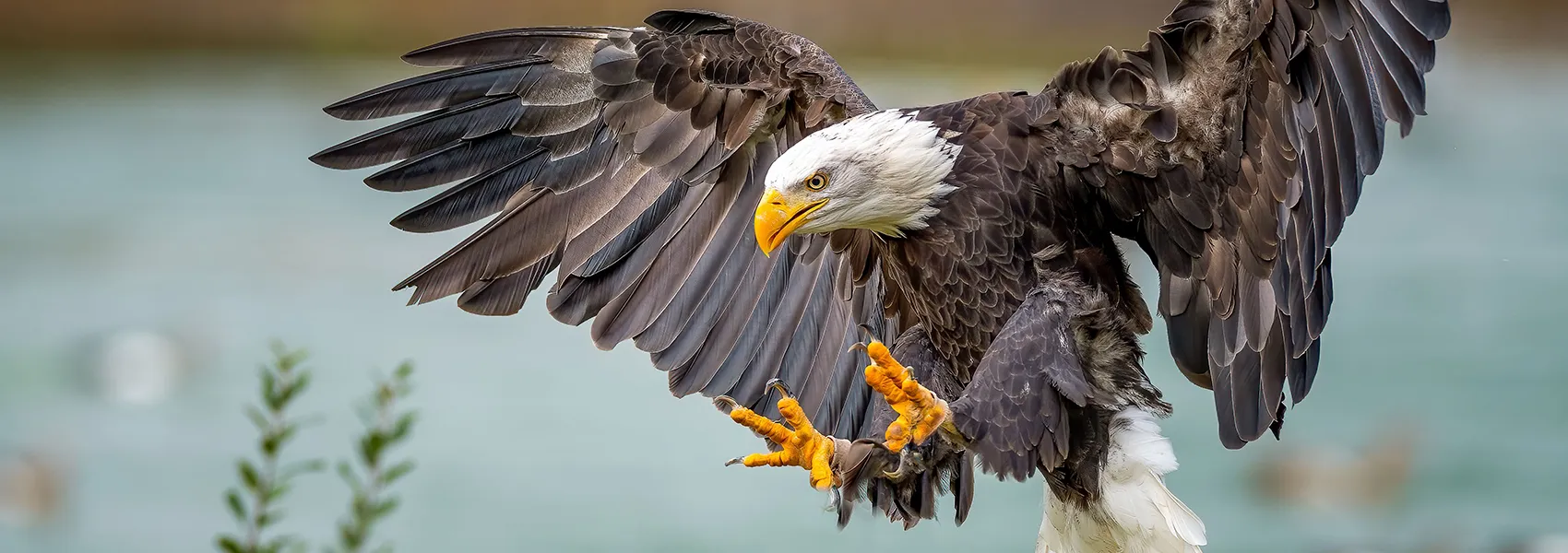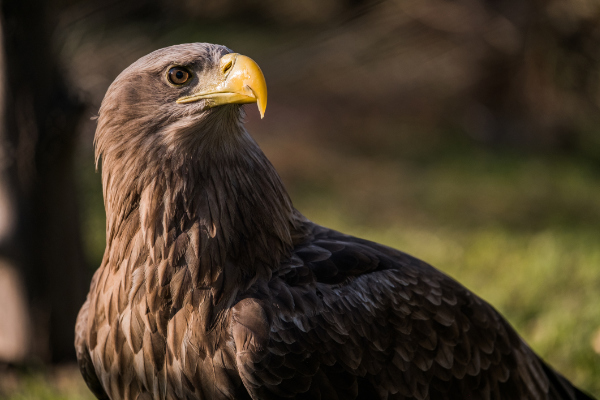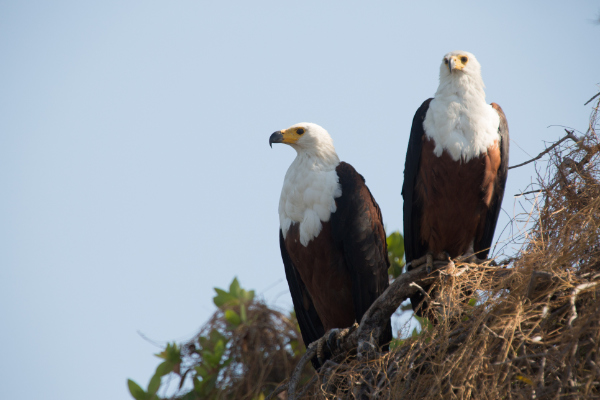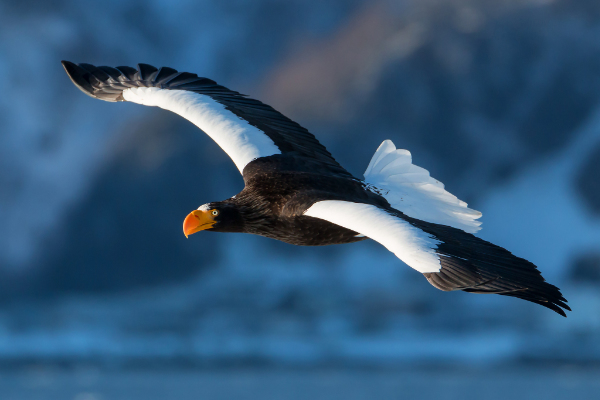
Published 11th Apr. 2024
Written by Hannah Whitehall
Reading time
Known for their enormous wingspans, terrifying talons and piercing gazes, eagles are fearsome birds of prey you may have been lucky enough to see gliding in the sky above you. But just how much do you know about the majestic eagle? From their cunning hunting tactics and keen eyesight to their popular symbolism, read on for an eagle education with our top ten eagle facts…
1. Symbolic power
2. Multiple species
3. Hunting prowess
4. Expert fliers
5. Gender roles
6. Life expectancy
7. Bird's-eye view
8. Balancing act
9. Superior swimmers
10. Adaptations
1.
Kicking off our list of eagle facts is a mention of their symbolic status. Widely synonymous with power, strength and freedom, the bald eagle – the national symbol of the USA – is perhaps the most famous example. Since 1782, it has been emblazoned on everything from official government seals and documents to the national currency. The eagle is also a sacred symbol for the First Nations people of Canada, believed to provide a link to the spiritual realm. It appears in the Bible, too, enjoying over 30 mentions, usually as a metaphor for God’s power. We’re calling it eagle-mania.
2.
Although you’ll probably only know a handful, there are actually over 60 species of eagle worldwide. Belonging to the Accipitridae family, these fearsome birds of prey are found on every continent except Antarctica, but most reside in Europe, Asia and Africa. Only two eagle species are native to the Americas: the golden and bald. The smallest of the lot is the South Nicobar serpent eagle, while the Steller’s sea eagle is the largest.

3.
A list of facts about eagles isn’t complete without a nod to their hunting prowess: the carnivorous bird is one of the largest and strongest in the world. With a diet consisting mainly of fish, eagles also eat other birds and small animals, including rodents, rabbits and bats (and even snakes). The harpy eagle takes the title of the strongest hunter, with the ability to tackle prey as big as them. Eagles like to play with their food, too. In mountainous regions, they’ll pick up large prey using their huge talons and kill it by dropping it from high cliffs. Clever or disturbing? You decide…
4.
Eagles are among the fastest birds on the planet, soaring up to 15,000ft high into the sky. Flying at an average speed of 50 mph, they can reach up to 100 mph when diving to catch a meal. Known for their effortless soaring, aerodynamic eagles conserve energy by gliding on top of thermal updrafts (columns of rising warm air) and utilising air currents to navigate the skies with minimal effort.
5.
Next up is the most romantic (yes, romantic) on our list of eagle facts: did you know that eagles mate for life? These lovebirds are monogamous, and they’ll only search for another partner if their current one dies or doesn’t return after a long period. Adhering to (rather, ahem, outdated) gender roles, the male provides for the pair and hunts for food, while the female keeps her egg safe and warm for around 35 days. Favouring the tough love parenting approach, eaglets aren’t taught to fly like other birds’ chicks. Instead, parents refrain from feeding their young so that they’re forced to fly in search of food themselves.

6.
Not sure how to tell the age of an eagle? Clue: take a look at their beaks. Eagles’ beaks bend more with age, so take note of how curvaceous their bills are if you’re curious. We’re only interested in facts about eagles here, so we won’t indulge the myth of dramatic eagle ‘rebirth’. With an average lifespan of around 20 to 30 years in the wild, the birds might weaken in strength as they become older, but there’s no intentional removal of beaks, talons or feathers to extend their lives.
7.
There’s truth in the phrase eagle-eyed. Although eagles’ eyes are similar in size and weight to humans’, their sight is far superior. With eyesight several times greater than ours, eagles are specially adapted to hunt in low-light conditions and are able to see prey from up to three miles away. Eagles’ eyes are located on the sides of their heads to give them an impressive 340-degree field of vision (meaning their prey doesn’t stand a chance).
8.
If you've not realised it yet, eagles are clever creatures. And when it comes to flying, these birds don’t mess around. If an eagle were to lose a couple of feathers on one wing, for example, it would purposefully shed the same number of feathers on the opposite wing. This keeps the eagle gliding gracefully through the air, perfectly streamlined and balanced. A pretty cool eagle fact, right?

9.
While eagles are better known for soaring through the sky, did you know that most are also excellent swimmers? Using their long, strong wings as paddles, eagles also have oily feathers which repel water and make them ‘waterproof’. The bald eagle is the strongest swimmer, with adept aquatic abilities that make catching a fish a walk in the park.
10.
We’re ending our rundown of eagle facts with a note about species variation. Generally, most eagles are very lightweight compared to their size, helping them glide efficiently through the sky. Females tend to be around 25% heavier than males, while most have either brown, white, black or grey feathers. Environmental factors also play a part in eagle adaptations; eagles are bigger in colder regions, while the birds’ wingspans are often shorter in forest regions than in open spaces.
Written by Hannah Whitehall
Practical advice and inspiration for your next trip

When you think of cherry blossom, we’d bet you picture Japan and its springtime Sakura. Now, we’re not denying that Sakura season is beautiful, but its reputation means it draws flocks of visitors, contributing to overtourism and disrupting local life. To combat this, we’re on a mission to shout about South Korea’s cherry blossom. Known locally as beotkkot, South Korea’s cherry trees bloom at a similar time to Japan’s and are just as breathtaking – without the pesky crowds (and skyrocketing costs).
20th October 2025 - South Korea The Natural World

Since the beginning of time, humans have been drawn to lakes, whether it’s to appreciate their beauty or see first-hand the places where monsters such as Nessie (Scotland) and Ogopogo (Canada) are said to reside. Fortunately, we’re spoilt for choice, from Lake Como’s bluer-than-blue waters to Moraine Lake’s magnificent mountainous backdrop. Fancy a trip to one of the world’s best bodies of water? Read on for our shortlist of the most beautiful lakes in the world… Lake Como,
9th May 2025 - The Natural World

Is it always possible to see the Southern Lights? No. Is it worth trying? Without a shadow of a doubt. The Southern Lights (aurora australis) are notoriously more difficult to see than their northern counterparts, but that only makes the swirling rivers of greenish blue even more spectacular when you do catch a glimpse of them. The best time to see the aurora australis is during the Southern Hemisphere’s darker, cooler months – from March to September – when the skies are clearest and the nights are longest.
14th March 2025 - The Natural World

Our team of destination experts will get to know you and your unique requirements for your holiday

We work with you to build an ultra-personalised holiday itinerary with your choice of accommodation, experiences and activities

All of our holidays include little extras designed to make a big difference to your trip, from fast-tracking you through airport check-in and security to our network of local Concierges